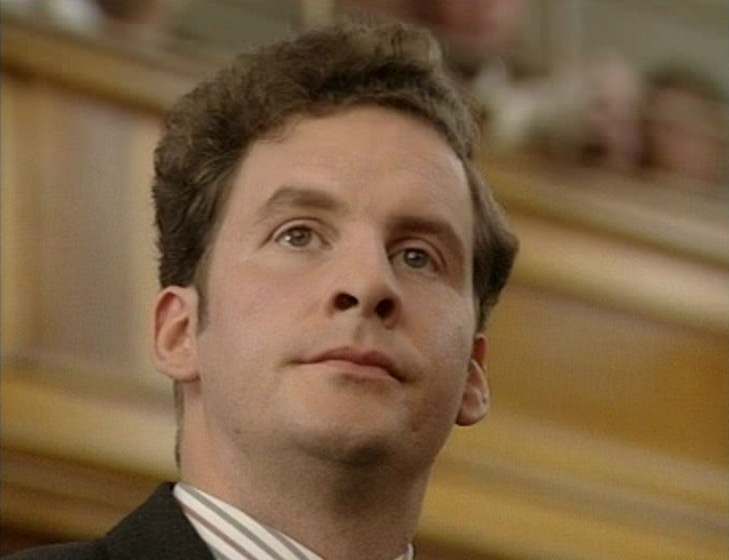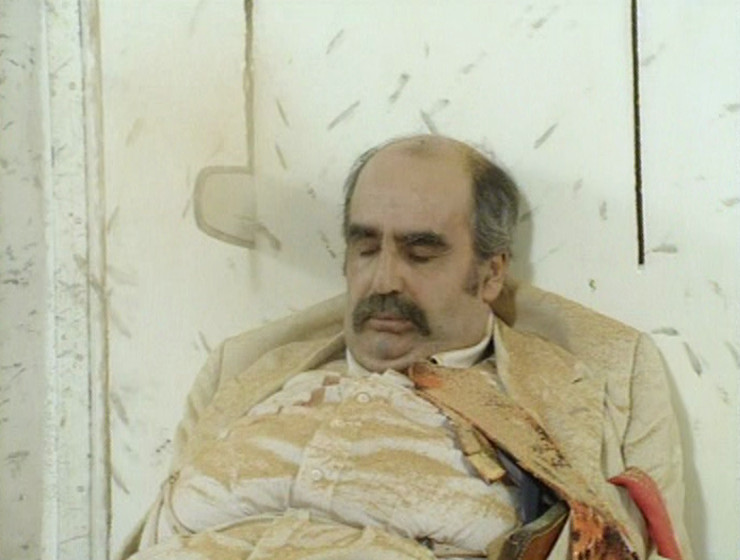
CLERK: Gordon Welsley Brittas, you are charged that you did on the 13th of November 1992 murder Julio Escobido, Eduardo Ramierz, Juan Mendosa, Robert Penchard, Ian Trahern – also known as Big Gary – and Raymond Watts… That you did have in your possession controlled drugs of class A, namely five kilos of heroin and an unknown quantity of amphetamines, contrary to Section 4 of the Misuse of Drugs Act of 1971.. and that you did unlawfully cause Grevious Bodily Harm to Alice Whitely, Grace Beatty, Agnes Swinton and Doreen Lavern-Smith, all of the Whitbury New Town Sunshine Retirement Home, contrary to the Offences of the Person Act 1861.
When The Brittas Empire returned for its third series at the beginning of 1993, it clearly wanted to grab the viewer. Instead of Brittas merely sitting in his office about to start the snowball rolling on another day of calamity, it had him up in the dock on charges of GBH, drug possession, and a murder or six. For most shows, perhaps that would have been enough of an attention-grabbing opener.
Not Brittas.
PROSECUTOR: Members of the jury, the main facts of this case are not in dispute. On the day in question, the police arrived at Whitbury New Town Leisure Centre, to find the lifeless bodies of seven men lying outside the squash courts, one of whom had been beheaded by the accused.
BRITTAS: I keep telling you, that was an accident!

Right away, a ticking time bomb has been set: 27 minutes and counting. If this is how you begin your episode, you’d better have a decent pay-off at the end. It seems – within the confines of a pre-watershed, mainstream sitcom – to be an almost impossible task.
But then, one of the biggest joys of The Brittas Empire is that it rarely pulls its punches.1 Here, we are promised a tale of death, destruction and decapitation, and that’s exactly what the show delivers. We are told Brittas decapitated somebody, and that is precisely what happens: no revelation that he only thought he had, or some improbable switcheroo. The guy’s decapitated. Alive. The question is: how?
Not that the episode merely coasts on that in-built tension. How we build to the key reveal is expertly handled. One thing that always stands out with Brittas is the intricacy of its plotting, and there is no better example than this episode. A less skilled writer would have simply had the framing courtroom scenes bookend the episode and have done with it. But no, we keep switching between the two; each scene ratcheting up the tension, pushing forward the plot… and tightening the screws on our hero.
The perfect example of this is with the gun, which the prosecution alleges was Brittas’s murder weapon of choice (that is, aside from a massive bloody chainsaw). It’s a small part of the overall plot, but everything slots into place perfectly:
PROSECUTOR: Did your employer explain why he had a gun in his office?
LINDA: Yes. He said he’d found it in lost property.
PROSECUTOR: Miss Lancing has given evidence that there was no gun in the lost property box when she gave it to Mr. Brittas just ten minutes before.
LINDA: Yes, I know.
PROSECUTOR: Is there some explanation?
LINDA: Oh, yes.
PROSECUTOR: And what would that be?
LINDA: I don’t know. But I’m sure he had one. Mr. Brittas always does!
A lot of sitcoms would have shoved the gun in there, given a cursory explanation, and moved on. The Brittas Empire takes the time to make sure every single thing ties up. The gun comes from the drugs cartel, fighting on the floors above a stairway; it falls into the lost property box after Laura has passed it over to Brittas; Brittas finds it once he has taken it into his office, and starts playing with it; Linda walks in, and Brittas accidentally fires the gun into the wall. “A remarkable shot, wouldn’t you say?”, says the prosecutor, as holds up a poster of a man… with a Brittas bullet-hole straight through the head. And if the whole thing is in danger of feeling purely like a mechanical plot device, some beautiful characterisation from Linda fixes that. With her youthful enthusiasm and belief in Brittas, she hangs him.
This is a murder mystery, plotted as a murder mystery rather than a stripped-down, “sitcom” version.2 Except we know Brittas is innocent… we just don’t know how he’ll prove it. A reverse Columbo, if you will.
Brilliantly, these courtroom framing scenes mean you can bring each regular character to the witness box – therefore reintroducing each character to the audience: their obsessions, their foibles, their relationship with our hero. It works as a second, introductory episode to the show. An absolutely brilliant conceit. And it also brings us the fabulous image of a vengeful Carole, standing at the witness box, clad in black, in mourning.

As the programme reaches its action-packed conclusion – with Brittas’s hand superglued to a chainsaw – the show has brilliantly managed to let you forget about the impending GBH charges. (It is testament to the utter chaos of the show that most of the audience will have forgotten such a thing was set up at the beginning of the programme: with practically any other sitcom, it would have been the main thrust of the entire show.) Most programmes, when faced with the prospect of your lead character careering through a pack of old ladies with a chainsaw severing their Zimmer frames, would chicken out. Show the character flying through the door, dub in some sound effects of old ladies screaming, cut away and have done with it. Too difficult to shoot, and hey, by showing it, you run the risk of killing the comedy by being too nasty. The Brittas Empire not only manages to show it, but shoots it brilliantly enough to be hilarious, not unpleasant. They took the difficult option, and made it work. If only more comedy – or, hell, television in general – took this route.
Of course, with that chainsaw, the final, horrible part of the promised decapitation slots into place. Of all images in the episode, this is the one that leaves its mark: the sheer violence of this episode is genuinely shocking. I could easily justify why it’s there – the fact the show doesn’t feel safe here is vitally important for heightening the comedy, etc etc etc. Ultimately though, there is undeniably a transgressive thrill in seeing exactly what the show managed to get away with at 8:30pm on BBC1. And if the camera inevitably cuts away before the actual moment, rest assured that we hear that chainsaw a split-second before it cuts into flesh. It pushes the moment as far as it could possibly go.

In the end, a vital witness steps forward – a young man involved in the drugs deal, who Brittas has managed to “save” with his inspirational talk – and Brittas is set free. (I like to think “I suppose I was scared of going to prison for twenty years… or being murdered by me gang mates” is a deliberately amusing bit of painfully obvious dialogue; much like “That’s breaking the Tenth Commandment, that is!” in Red Dwarf X’s Lemons. You may, of course, consider me over-generous on both counts.) It’s a fitting resolution to the story, even if the idea of Brittas actually doing good for the world is done better (and more touchingly) later on – most notably in the first episode of the very next series, with a lovely subplot involving a single mother and her young daughter.
With all the preceding, you may have thought the episode had done enough; but there is one last twist in the tale – and I can’t bring myself to ruin it here. Suffice to say that – in true Brittas Empire form – it manages to clarify a key element of the story that most people would have forgotten about by this point… and also ties the framing courtroom sequences and the main leisure centre story together in beautiful fashion.
Some of you may remember my worries about the BBC’s current attitude towards audience sitcom, as exemplified by this post on BBC writersroom. Here was the key quote that concerned me:
“In non-studio comedy series you can do strange, subtle, unusual things – think The Office, Peep Show, The Thick of It, Flight of the Conchords. In studio sitcoms, you have to make the people in the room laugh – out loud, and preferably as often as possible.”
The idea that these two things are mutually exclusive is absolute madness – and insulting to audience sitcom and non-audience sitcom alike. Maybe this episode lacks a certain amount of subtlety – but hell if it isn’t doing strange and unusual things. Things that more audience sitcom these days should be doing.
The episode as a whole perhaps is ultimately a shaggy dog story. There are more meaningful episodes of the series; there are more character-based episodes; and whilst it’s not lacking in that regard, there are funnier ones. As an attention-grabbing first episode to watch however, it’s hard to beat – and there is no finer example of the show’s attention to detail in its sheer construction. Moreover, no other episode more explicitly evokes what Mark Lewisohn calls the programme’s “unusual obsession with death and danger”. The world of Brittas is many things: but one thing it isn’t is safe. And that’s an extremely good thing.
If your memory of The Brittas Empire is that it was nothing special, I urge you to give this episode a try. There is no better introduction to the programme. To say nothing of the fine work the episode does fighting people’s ignorant and stereotypical views of South America.

Say nothing.

One comment
Dave Jeffery on 16 February 2014 @ 1pm
Another comedy I really enjoyed that starts with a very similar scene is “Sykes and… The Hypnotist”.
Comments on this post are now closed.